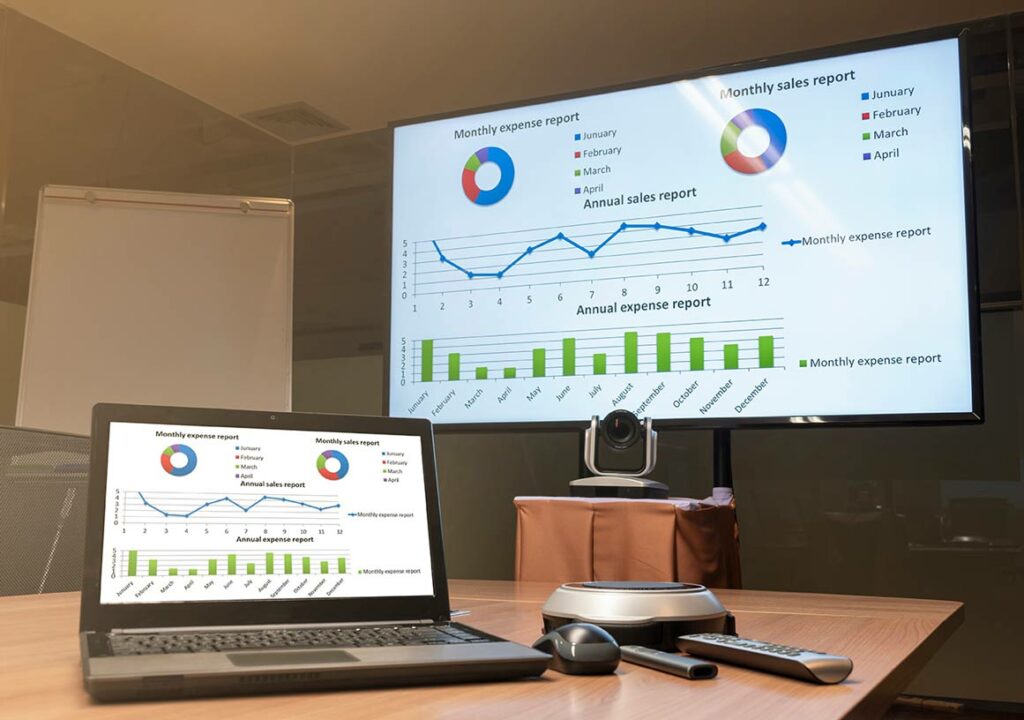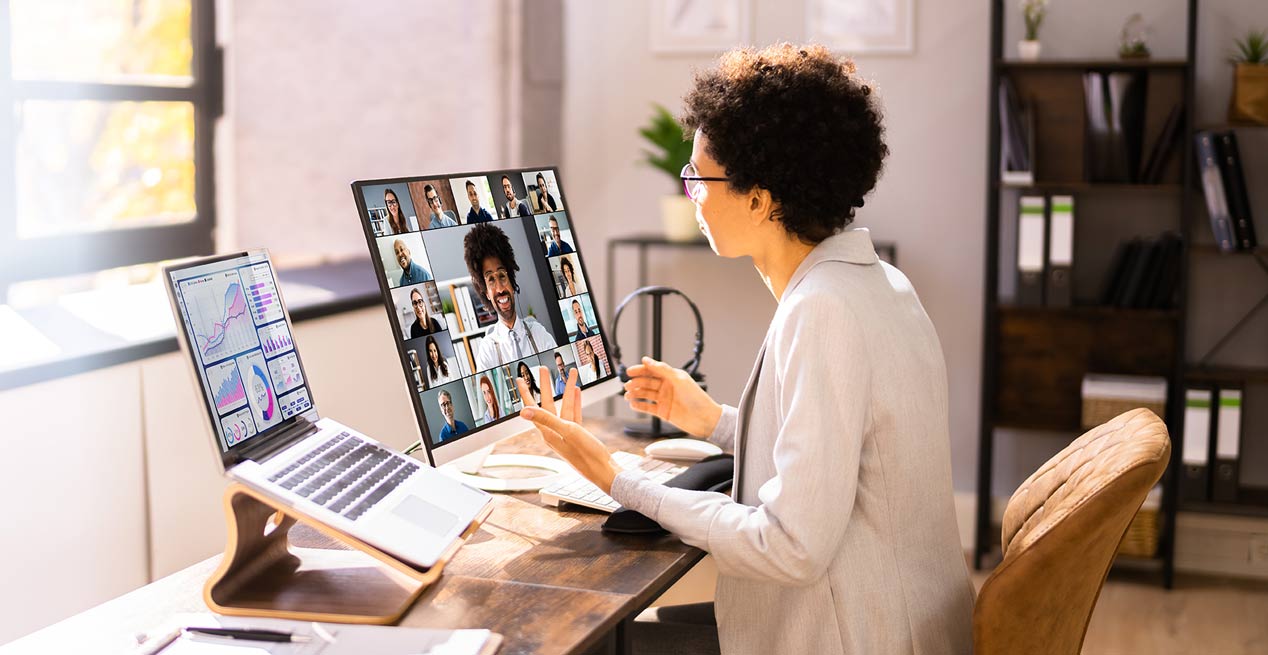You may be asking yourself, well how do I put together an excellent presentation? This is a question that teachers, remote workers, even managers ask themselves at first because this can have a different dynamic than a normal in-person presentation. There are many factors that people overlook such as body language, eye contact, facial expressions, and even eye level, just to name a few. While people tend to look past how they should appear during an online presentation, this is a major element to your virtual audience. We will cover the key elements on how to improve your next online meeting so that you don’t miss out on the best information available!
Appearance
Once you have a nice outfit picked out for yourself, next is your setting. What room in your house is the best for this? The best room to pick to set up in is a quiet room. This may be a spare room that is used for office space, or possibly even the living room or kitchen is a better place for you to be. Keep in mind your lighting situation as well, so you can get the clearest visual from your camera. If you are the host, be extra sure that you’re in good lighting because all eyes will be on you. No one likes to see a dark room while having to focus on that same exact room the entire presentation.
Wherever you chose to set up, make sure that the distractions are taken care of and pushed out of your mind before the presentation begins. This will help you feel more comfortable during your meeting Also, don’t forget to tidy up! Making sure you have a clean background with no boxes or laundry is a key element too. This can lead to major distractions as well as having your privacy taken away if you pick a room or location that hasn’t been fully thought through.

Equipment
Now that you’re looking professional and have picked out a good room to get started in, the next step is to check your equipment and make sure that everything is working correctly on whichever virtual platform you are using. Beginning with the camera, turn it on and make sure your picture is clear and responsive. Once that looks good, next would be your microphone. To check your audio quality turn on your microphone and, depending on your presentation platform, you should be able to run a quick sound test to make sure it’s operating correctly. Since your camera and microphone are generally built into your computer, these should be easy to test right in your preferred video conferencing platform’s online settings. If you are using a higher quality microphone or camera, check your computer’s settings to test those out as they may have specifics to them different than your built-in equipment.
Content
So now you have a great-looking outfit and you’re in a quiet room. Great! Now you can begin to look at the next element which is your content. Content is extremely important to the overall message of your presentation. If your content is not interesting, your audience’s attention will not be yours for long. Now chances are you already have some content you want to include. If not, then you want to make sure you have the best information to elevate your work to an amazing presentation, so get researching!
Depending on how long your presentation may be, you might want to include an agenda early on. This will set a tone for how the rest of the meeting will flow. Next would be to make sure that you’re keeping your slides simple. Adding too many sentences on each slide could easily cause distractions or just lose your audience completely. Instead, find a professional slide design that will keep your audience engaged throughout the meeting on every slide. Using pictures and visuals works extremely well too, as long as they are on message and not too distracting.
Some meeting platforms allow presenters to control video playback to the audience, a huge quality improvement over screen sharing video from the presenter’s screen. Video is our most exciting and memorable medium. Use it sparingly, in doses of 2 minutes or less. If the video is longer, pause it for comments and discussion.
Depending on your presentation style or comfortability, some hosts will leave the chat window open for any audience questions they may have during the meeting. Some, however, will ask that any questions be saved for the end, to lessen the chance of distractions or getting off-topic. Make this known at first if you’d like, just to keep the meeting a little more organized and to keep it moving. You can also prompt the audience to ask questions at appropriate times during your presentation. A very important piece of content is the last slide, as this is typically a “Wrap-Up” slide. It will give a brief summary of what the presentation included and is very important if you decide to have the audience save their questions for the end.

Vocal Energy
Now that you have some good content created and ready to go, you need to know how to successfully present your information. You’ll want to work on replacing your physical energy with vocal energy. Physical energy is great when you’re onstage where people can see your entire body, but it will not transfer over the same way into a virtual meeting. Working on your tone, pace, volume, and intensity can help this tremendously. Some people talk fast, while others talk slow and low. These are difficult voice styles to try to follow as an audience member while also trying to retain information at the same time. Speaking at a normal pace with clear words is the best way you can provide the information to your audience.
Go through your whole presentation while trying out your new “presentation talk” to get more familiar with it. Not only will this help you find your rhythm but you will also be less likely to get hung up on something during your actual presentation. You may also have important words or phrases in your content that need to stand out, so make sure you’re really emphasizing them to get the message across. Some hosts also find it helpful to create notes for themselves if they have a heavy load of information they’d like to freely talk about. Having a good mix of both speaking and visual pieces in your presentation will certainly help your audience leave the meeting with as much information as possible.
Presenting
Before presenting, it’s recommended to have a certain time slot allocated for your meeting to keep everything on track. Once your audience begins to show up, greet them and thank them for joining you.
When everyone arrives, give them a quick rundown of your expectations for the presentation and ask if they have any questions before you begin. This will give you a little more transparency while also easing the tension that an online presentation could create. After that just go right into your presentation and take your time getting through it. If you rush, the audience will notice and they will be losing information as the presentation goes on.
If you have any slides that open the floor up for discussion, make sure to set enough time to aside. When you get to your last slide, summarize and reinforce the ideas you’ve presented. This will let your audience have time to ask any questions they may have for you. Make sure each question gets answered. If that’s impossible be sure to set a time for a follow-up with that audience member. Remember to thank everyone for coming and remind them of any upcoming presentations, events, etc.
